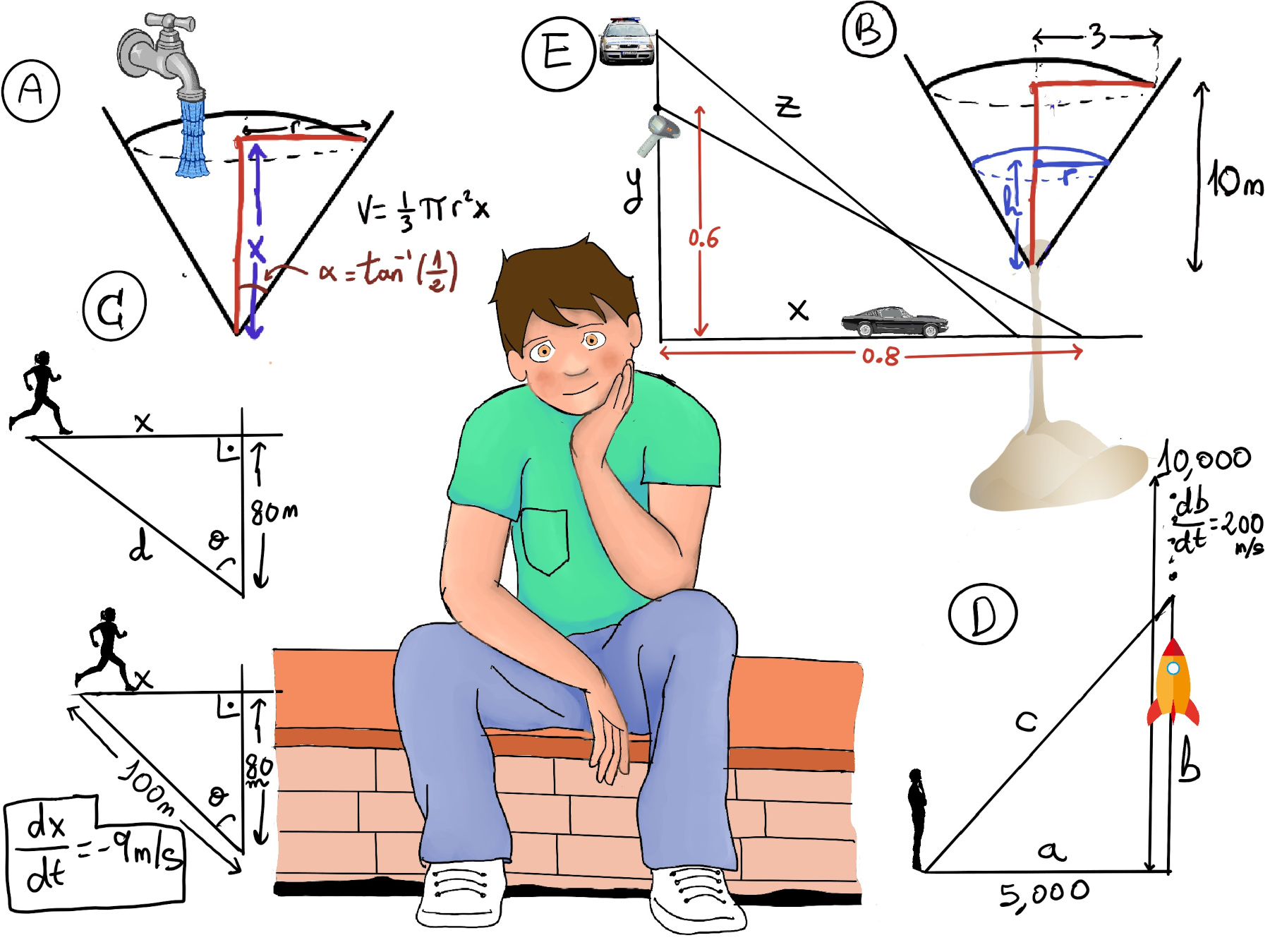
|
 |
 |

|
 |
 |
Perfect is the enemy of the good.
The derivative of a function at a chosen input value, when it exists, is the slope of the tangent line to the graph of the function at that point. It is the instantaneous rate of change, the ratio of the instantaneous change in the dependent variable to that of the independent variable.
Definition. A function f(x) is differentiable at a point “a” of its domain, if its domain contains an open interval containing “a”, and the limit $\lim _{h \to 0}{\frac {f(a+h)-f(a)}{h}}$ exists, f’(a) = L = $\lim _{h \to 0}{\frac {f(a+h)-f(a)}{h}}$. More formally, for every positive real number ε, there exists a positive real number δ, such that for every h satisfying 0 < |h| < δ, then |L-$\frac {f(a+h)-f(a)}{h}$|< ε.

The critical points of a function f are the x-values, within the domain (D) of f for which f’(x) = 0 or where f’ is undefined. Notice that the sign of f’ must stay constant between two consecutive critical points. If the derivative of a function changes sign around a critical point, the function is said to have a local or relative extremum (maximum or minimum) at that point. If f’ changes sign from positive (increasing function) to negative (decreasing function), the function has a local or relative maximum at that critical point. Similarly, if f’ changes sign from negative to positive, the function has a local or relative minimum.
f’(x) is the slope of the line tangent to the graph of f at that particular point (x, f(x)). f’(x) is also the rate of change of the function at x. The average rate of change is the process of calculating the rate at which the output (y-values) changes compared to its input (x-values). This can be visualized as the slope of a secant line passing between two points on a function. In differential calculus, the focus shifts to the instantaneous rate of change, which is found using the derivative of a function.
For example, Growth Rate = $\frac{Births-Deaths}{years}$. The rate of change in population is the derivative of the population function with respect to time, $\frac{dP}{dt}$.
You should follow these general steps:

The first step is to fully understand the problem and represent it (Figure C). $\frac{dx}{dt} = -9 m/s$. Goal = $\frac{dθ}{dt}$ at the instant given (when the distance between him and the runner is 100 m.)
Using basic trigonometry, tan(θ) = $\frac{x}{80} ⇒ \frac{d}{dt}(tan(θ)) = \frac{d}{dt}(\frac{x}{80}) ⇒ \frac{d}{dt}(tan(θ)) = \frac{1}{80}\frac{dx}{dt}.$
At this particular time, $\frac{d}{dt}(tan(θ)) = \frac{1}{80}\frac{dx}{dt} = \frac{-9}{80}.$
$\frac{d}{dt}(tan(θ)) = sec^2(θ)\frac{dθ}{dt} = \frac{-9}{80}$. We also know that sec(θ) = $\frac{1}{cos(θ)} = \frac{1}{\frac{80}{100}} = \frac{100}{80} ⇒ \frac{dθ}{dt} = \frac{\frac{-9}{80}}{sec^2(θ)} = \frac{\frac{-9}{80}}{\frac{100^2}{80^2}} = \frac{-9·80}{100^2}$ = -0.072 rad/s.
The first step is to fully understand the problem and represent it (Figure 2.c).
We know that tan(θ)=h⁄2 and $\frac{dθ}{dt} = 5° per second$. Goal: $\frac{dh}{dt}~ when~ θ=50°$.

$tan(θ)=\frac{h}{2}$⇒[Let’s differentiate by t] $sec^{2}θ\frac{dθ}{dt} = \frac{1}{2}\frac{dh}{dt}⇒\frac{dh}{dt}=2sec^{2}θ\frac{dθ}{dt}=2·sec^{2}(50°·\frac{\pi}{180})·5°·\frac{\pi}{180} ≈ 0.422mps ≈ 1520.7mph$ -simple conversion mps to mph, 0.422·3.600-
V = x3, we know that $\frac{dV}{dt} = -9.72m^3$ our goal is $\frac{dx}{dt}\bigg|_{x=12}$
$\frac{dV}{dx} = 3x^2, -9.72 = \frac{dV}{dt} = \frac{dV}{dx}·\frac{dx}{dt} = 3x^2·\frac{dx}{dt} ⇒ \frac{dx}{dt} = \frac{-9.72}{3x^2}$
$\frac{dx}{dt}\bigg|_{x=12} = \frac{-9.72}{3·12^2} = -0.0225 m/s$

$\frac{dV}{dt} = 14$, α = $tan^{-1}(\frac{1}{2}) ↭ tan(α) = \frac{1}{2} = \frac{r}{x} ⇒ r = \frac{x}{2}$
V = $\frac{1}{3}π·r^2·x = \frac{1}{3}π·(\frac{x}{2})^2·x = \frac{1}{12}·π·x^3 ⇒ \frac{dV}{dx} = π·\frac{1}{4}·x^2 ⇒ \frac{dx}{dV} = \frac{4}{π·x^2} ⇒ \frac{dx}{dt} = \frac{dx}{dV}·\frac{dV}{dt} = \frac{4}{π·x^2}·14, \frac{dx}{dt}\bigg|_{x = 8} = \frac{4}{π·8^2}·14 ≈ 0.28 m/s.$
The diagram is shown in Figure 2.a. By the Pythagorean theorem (we can never thank him enough), x2+302=D2 (Initially, D = 50 ⇒ x =$\sqrt{50^2-30^2}$ = 40) and $\frac{dD}{dt}=-80.$ Goal: $\frac{dx}{dt}?$

x2+302=D2 ⇒ $2x\frac{dx}{dt} = 2D\frac{dD}{dt}$
Now, we can plug the values in the previous equation, $2x\frac{dx}{dt} = 2D\frac{dD}{dt} ⇒ 2·40·\frac{dx}{dt} = 2·50·(-80) ⇒ \frac{dx}{dt} = -100 ft/sec.$
|-100 ft/sec| > 95 ft/sec = 65mph. Yes, you are speeding 🚗, but not for much.
Let P(t) be the population of a city t years from now (we are going to be using thousands as unit). P’(0) -the current growth rate- ≈ $\frac{P(5)-P(0)}{5 -0} = \frac{30-10}{5} = 4.$
For small values of h (in other words, being relatively close to a), f’(a) ≈ $\frac{f(a+h)-f(a)}{h}↭ f(a+h) ≈ f(a) + f’(a)h$ (this is the Linear approximation of a function). In our particular case, a = 0, h = 2, P(2) ≈ P(0) + P’(0)·2 = 10 + 4·2 = 18 ⇒ 18,000 will be the population of the city in two years.

Figure B. Let h be the height of the sand. Recall that similar triangles have the same corresponding angle measures and proportional side lengths ⇒ $\frac{r}{h} = \frac{3}{10} ⇒ r = \frac{3}{10}·h$ (i)
$\frac{dV}{dt} = -0.5, V = \frac{1}{3}π·r^2·h$
V = $\frac{1}{3}π·r^2·h =$[Replacing r by (i)] $\frac{1}{3}π·(\frac{3}{10}·h)^2·h = \frac{3π}{100}h^3 ⇒ \frac{dV}{dh} = \frac{9π}{100}h^2 ⇒ \frac{dh}{dV} = \frac{100}{9πh^2}$
$\frac{dh}{dt} = \frac{dh}{dV}·\frac{dV}{dt} = \frac{100}{9πh^2}·-0.5 = \frac{-50}{9πh^2} ⇒ \frac{dh}{dt}\bigg|_{h=2} = \frac{-50}{9π4} = \frac{-25}{18π}$≈ -0.44 m/s.